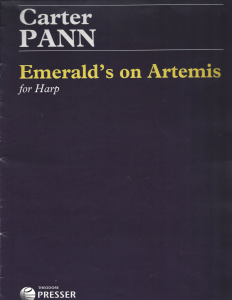
Composer and pianist Carter Pann has written a lovely solo for pedal harp, published by Theodore Presser. “Emerald’s on Artemis” is a welcome addition to the harp repertoire. The inscription above the title reads “A music box for Emerald Weber (born 18 June, 2010) on Morgan Black’s harp, Artemis.” Apparently, Pann wrote the piece in celebration of the birth of the first daughter, Emerald, of a close childhood friend. It was to be played by harpist Morgan Black on his instrument named “Artemis.”
The piece, published in 2016, is five pages in length. At times, it is as gentle as a lullaby and at other times, it oozes excitement for a new life. It begins quietly with several harmonics. There are more than 25 meter changes, the most unusual being 15/8 and indicated as an easy carousel.
Most of the piece is in seven flats, so the harp is at its fullest resonance. The music dances around the harp and one can imagine observing a newborn with the joyful effect of the notes. Pedal changes are notated below the staff. The music is challenging in spots, but well within the capabilities of an intermediate to advanced player.
If you want something original, modern, and gratifying to play, try “Emerald’s on Artemis”—you’ll find out why Carter Pann is a Grammy-nominated artist.
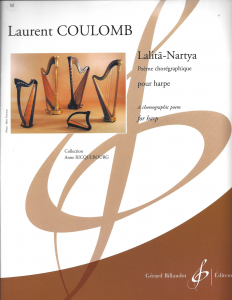
Another more recent original solo for pedal harp is “Lalita-Nartya” (a choreographic poem for harp). It was written by Laurent Coulomb and published by Gérard Billaudot. This piece has an interesting and unusual origin. Dancer Églantine Bisserier suggested the composer write a piece to accompany some existing choreography. The composer explains the title is both an homage to the dancer who inspired the piece and an evocation of the Hindu goddess, Gaudi.
A dotted rhythm is featured throughout the five pages of this piece. The listener can feel the personality of the classical Indian dance that inspired the music. An engaging introduction is followed by a brief anticipation of the main theme. A dramatic glissando introduces several short, thematic motifs. The dance winds down with a slow, pensive arpeggio, leading to a few final notes.
The ideal presentation of this composition would be with a dancer, but it could also be performed as a solo on a concert program. Suitable for the upper intermediate to advanced player, this is a different piece that should stimulate the imaginations of the audience.
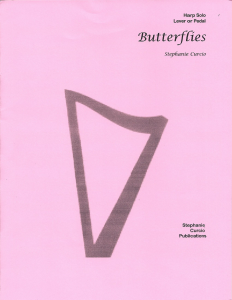
Stephanie Curcio has written and published a lovely new solo for pedal harp called “Butterflies.” It is dedicated to her student, Emily Richardson, and to the New Hampshire Hospital for Children. Each year, they hold a butterfly release ceremony in remembrance of children lost to illness or tragedy. Emily has been harpist for this event.
Presented in D-flat, it is written entirely in the treble clef and played in the upper registers for a light and airy feel. The grace notes give the effect of a butterfly flitting from flower to flower. Eighth notes that go back and forth between adjacent strings, as well as ascending and descending glissandi suggest the fluttering of a butterfly.
There are some pedal changes in the glissando section. The changes are notated in the middle of the staff where they won’t be missed. The G-flat and C-natural pedal changes that should occur around m. 49 were omitted. The piece ends with one final scale gliss. It is three pages long and some fingering is suggested. It is not difficult and would be a good piece to teach students how to musically evoke a theme.
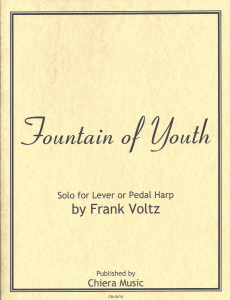
A prolific source of original music is Frank Voltz, and “Fountain of Youth” is just one of several of his recent publications. Appropriate for pedal or lever harp, it is almost five pages and published by Chiera Music.
This is sight-readable for an intermediate player and attainable for a beginner. A theme is established in the first few measures that is repeated a couple times throughout the piece. There are nice rolled chords on the downbeat in the first section. The second section is downward arpeggios—mostly stacked thirds or inversions which fall comfortably in the hands. There is a scale gliss, a few grace notes, and one easy pedal or lever change. Fingering is suggested where it is helpful and the typesetting is easy to read.
This is a very pleasant melody in F major that could be played in a variety of settings.
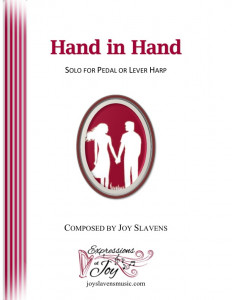
Finally, a recent publication by Joy Slavens provides original music for the more beginning level player. “Hand in Hand” is a sweet melody in G major available from joyslavenmusic.com. It includes scale glisses, thumb slides, an arpeggiated left hand accompaniment, and a few very easy lever or pedal changes. It is four pages. There are two page turns because of the layout, but they are manageable.
A recurring theme is first played with sixths in the right hand. It is then repeated in an arpeggiated section. There is a secondary section in E minor that is concluded with a scale gliss leading back to the main theme. This likable tune is meant to be a love song. It is challenging but within reach for a beginner and sight-readable for an intermediate player. •
Jan Jennings is the music review editor for Harp Column and is the author of The Harpist’s Complete Wedding Guidebook and Effortless Glissing. Email her at
mail@harpbiz.com.






